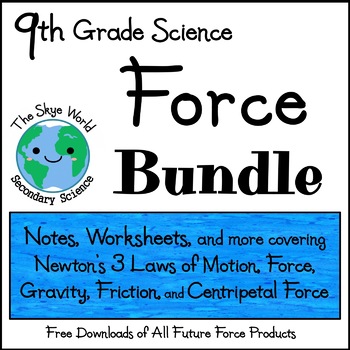Bundle of Lessons - Force
- Zip
Products in this Bundle (7)
showing 1-5 of 7 products
Also included in
- This growing bundle covering a year of curriculum for 9th and 10th grade physical science (integrated physics and chemistry) includes the bundles of activities listed below. All lessons are aligned to the TEKS (Texas Knowledge and Skills). Bundles include notes, worksheets, card sorts, task cards,Price $274.00Original Price $420.00Save $146.00
Description
This bundle will prepare students to identify Newton's 3 laws of motion as well as solve simple problems including force calculations using Newton's 2nd Law of Motion. By completing this activity, 8th and 9th grade science students will learn how to calculate force problems.
Included skills:
- Simple problems to introduce force calculations using Newton's 2nd law of motion
- Students solve problems using the variables mass, acceleration, and force
- Metric units used in every problem including kilograms, kilometers, and Newton-meters (Joules)
- Teach students to show their work step by step with columns for formula, work, and answer with units
- Teach students to set up word problems with ease
- Build student confidence
- Answer keys always included
- No need for calculators; perfect way to review basic math skills
- Recommended for 9th grade science, Physical Science, IPC (Texas), algebra-based Conceptual Physics, and STEM classes
Also found in this money saving bundles
9th and 10th Grade Physical Science Growing Bundle of Lessons
TEKS Covered
I.3F - history and contributions of scientists
I.4C - investigate how an object's motion changes only when force is applied
I.4D - describe and calculate force, mass, and acceleration
I.4E - conservation of momentum using action and reaction forces
I.4F - describe the gravitational attraction between objects
NGSS Standards Covered
MS-PS2-1
MS-PS2-4
HS-PS2-1
HS-PS2-4
Find physics and chemistry problems at The Skye World Science:
AND MORE!!!!!
Terms of Use – copyright ©Catherine Skye All rights to this product are reserved by author. This authorizes one teacher to use this product. If you want to share it with other teachers, please purchase a license to share this work. Copying by more than one teacher, classroom, department, school, or school system is prohibited UNLESS you purchase a license. Clipart and elements found in this PDF and others on my site are from the public domain unless otherwise noted. All products on my site are intended for classroom and personal use and may not be digitally copied for reuse in any form. Any misuse is considered copyright infringement and violates the DMCA (Digital Millennium Copyright Act).



